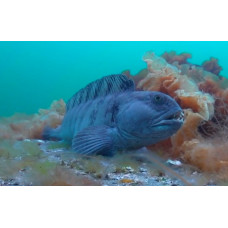Latin name
Anarhichas lupus
Other name
Seawolf, Atlantic catfish, ocean catfish, devil fish, wolf ee, woof or sea cat.
Identification
The body of the Atlantic wolffish is elongated, tapering to the tail, and covered with fine cycloid scales. The head is large, massive, with a rounded snout. The teeth are arranged in several rows on the jaws, palate and vomer. The front teeth at the ends of the jaws are fanglike. The vomer teeth are shorter than the palatal teeth. There are 72-78 vertebrae. A lateral line extends to the caudal peduncle.
Features of fish fins
The long dorsal fin of these fish has 69-77 soft, unbranched rays. The anal fin has 42-48 soft rays, shorter than the dorsal fin. The caudal fin is truncated and does not join the dorsal and anal fins. Pectoral fins are large with 18-20 rays and rounded edges. There are no pelvic fins.
Fish colouring
The body coloration of the Atlantic wolffish is brown, bluish gray or yellowish. There are 9-12 dark horizontal stripes on the sides of the body, which also extend to the dorsal fin.
Distribution
Widespread in the North Atlantic and Arctic Oceans. Found in the North, Norwegian and Barents Seas; waters around Greenland, Svalbard, Labrador, Newfoundland, Novaya Zemlya; common in the western part of the Baltic Sea and the White Sea.
Habitat
Demersal oceanodromous fish, inhabiting depths from 20 to 435 meters, usually over rocky substrates.
Size
The maximum length of these fish is 150 cm, weight - up to 23.6 kg.
Behavior
Atlantic wolffish lead a solitary life.
Food and feeding habits
This species feeds on mollusks, echinoderms, crustaceans and fish.
Reproduction
First mature at 5-6 years of age, and 50% of individuals mature at 50-60 cm body length at 8-10 years of age. They spawn in July and February. In the north-south direction, the spawning season shifts from summer to winter months. Eggs are large, 5-6 mm in diameter, and are deposited among rocks in the form of spherical clutches. Eggs are glued together by parts of the shell. Fecundity from 600 to 40 thousand eggs. Incubation period is 4-9 months. The male guards the clutch.
Fishing
Valuable commercial fish. The main fishery is in the North Sea and the Barents Sea. Fishing is done with trawls and longlines.
Relationship with a person
Harmless. Atlantic wolffish have dense, high quality meat.
| Classification | |
| Phylum | Chordata |
| Class | Actinopterygii |
| Squad | Perciformes |
| Family | Anarhichadidae |
| Genus | Anarhichas |
| Species | A. lupus |
| Features | |
| Conservation status | Data Deficient |
| Habitat | Bottom |
| Life span, years | No information |
| Maximum body weight, kg | 23,6 |
| Maximum length, cm | 150 |
| Sailing speed, m/s | No information |
| Threat to people | Edible |
| Way of eating | Predator |
Atlantic wolffish
Tags: atlantic wolffish




